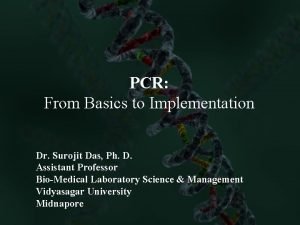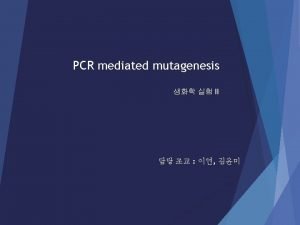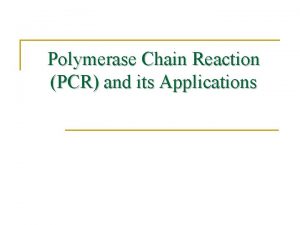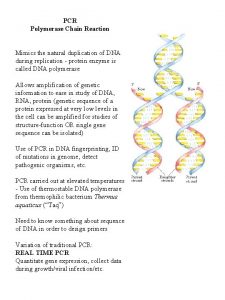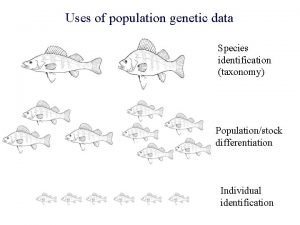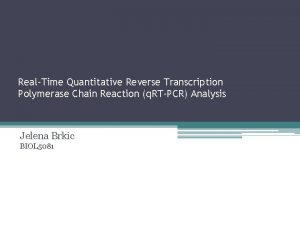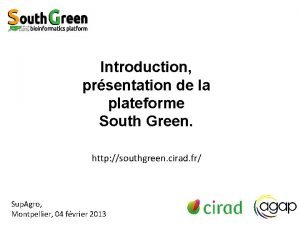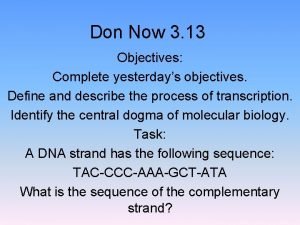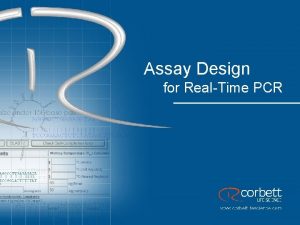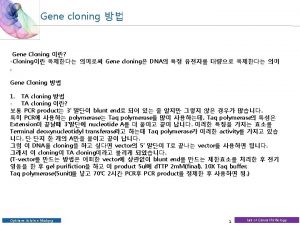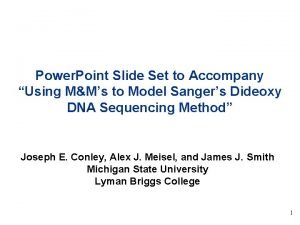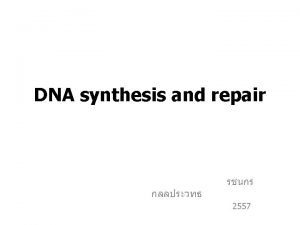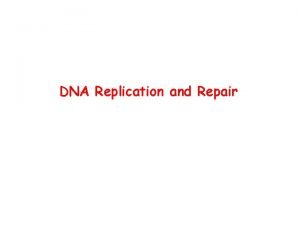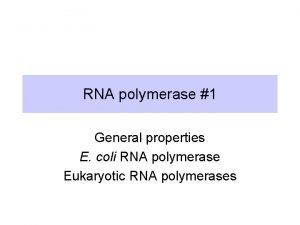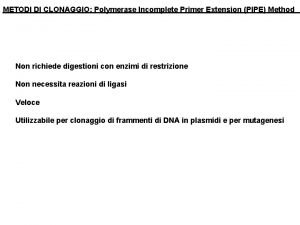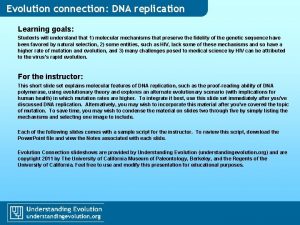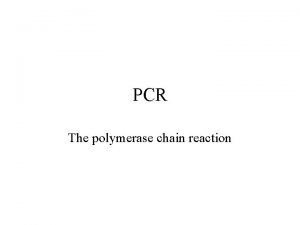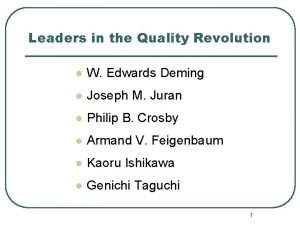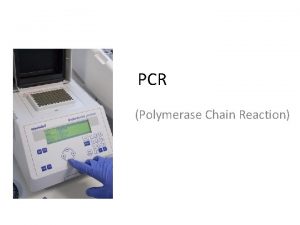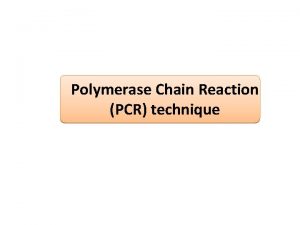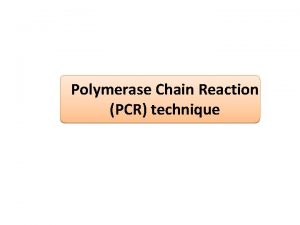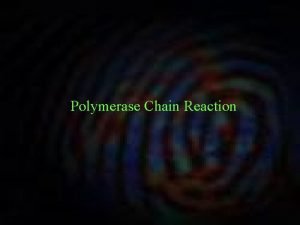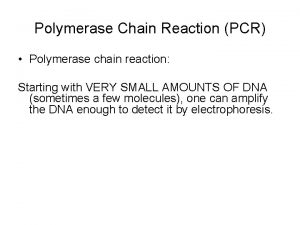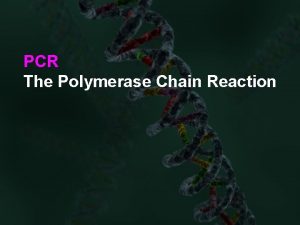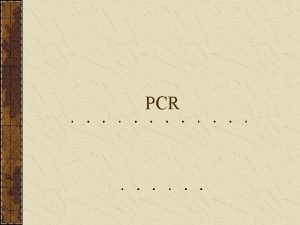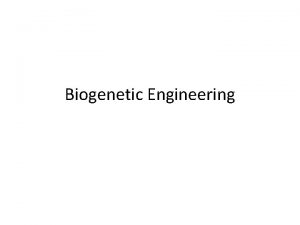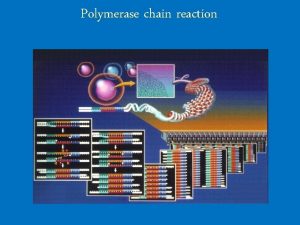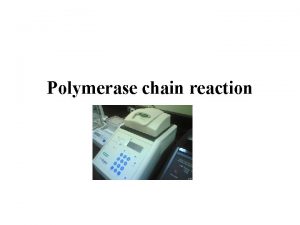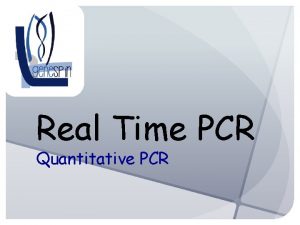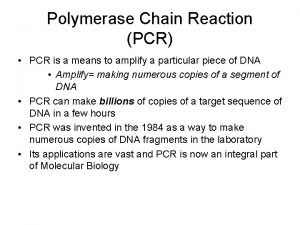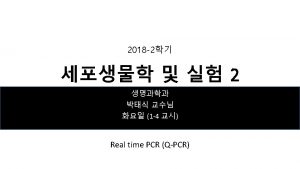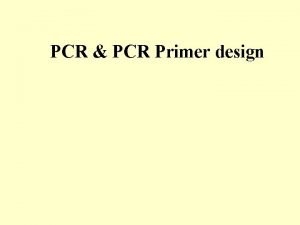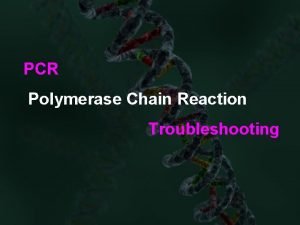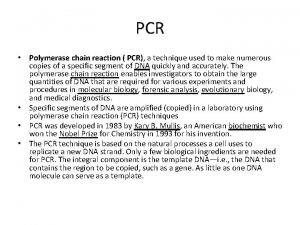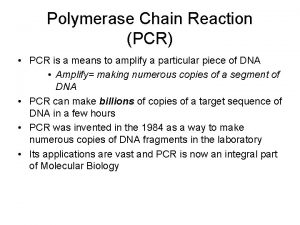The PCR The Polymerase Chain Reaction The Polymerase































- Slides: 31

The PCR The Polymerase Chain Reaction


The Polymerase Chain Reaction • The PCR is used to make copies of DNA (amplification). • Whole genome OR • DNA fragments

The Polymerase Chain Reaction • Uses a thermal cycler. • Repeated cycles of heating, cooling and reheating. • Number of DNA strands doubles with each cycle.

The Polymerase Chain Reaction Ingredients: - DNA to be copied Primers DNA polymerase Nucleotides

Primers – bind to DNA to allow DNA polymerase to work DNA Short (18 -24 bases) Single stranded Base sequence complementary to each end of the target DNA • One sequence for each DNA strand • •

DNA Polymerase • Needed to join sugar-phosphate backbone of new DNA strands. • DNA Taq polymerase is derived from bacteria that live in hot springs. • Not denatured by high temperatures required for the PCR to work.

The PCR – How it works 1. Heat to 95°C to break H-bonds between nuclotides and separate DNA strands. 2. Cool to around 60°C to allow primers to anneal (bind) to DNA. 3. Heat to 72°C to give DNA Taq polymerase the optimum temperature for it to join the sugar phosphate backbone of each new strand. These stages are repeated 20 -35 times. How many DNA strands will be present after 5, 10 and 20 cycles?

PCR Puzzle Class instructions

Start of lesson • Have the following at front of the class: • Template

Start of lesson continued • Primers • Bases

Correct base pairing is critical! • Green (Guanine) pairs with yellow (Cytosine) • Blue (Adenine) pairs with orange (Thymine)

The devil is in the detail! • The 5’ prime and 3’ prime ends of the bases must be round the right way!

Cycle 1 - denature • Spilt class in 4 pairs or groups of students • Each group will copy one STRAND from the template • Thus, it is important to think of a template as two strands rather than one double stranded piece of DNA

Cycle 1 - denature • Two groups will do the first cycle • Give Group 1 one template strand • Give Group 2 the other template strand

Students comes to front to get primer • One student from each group comes to front of class to get primer

Students comes to front to get primer • If they have double orange in their template, pick one double blue primer • The other group takes one green-blue primer

Cycle 1 - Anneal primer • Each group adds primer to the template • Make sure 5’ to 3’ prime is correct!

Cycle 1 - extend • Students take bases required to finish strand • And add the bases to complete the copy

Cycle 1 - observations • When finished filling in blanks, each group brings product to front of class and put on desk

Cycle 1 - observations • Make observations: – How many copies do you get? – How many are just the target sequence (i. e. begin and end with primers)?

Cycle 2 - denature • Groups 1 to 4 will do Cycle 2 • Give each group a strand:

Cycle 2 – Anneal primer • Each group adds appropriate primer to the template strand • Make sure 5’ to 3’ prime correct way round!

Cycle 2 - extend • Students take it in turns to come to front to take matching base to add to template

Cycle 2 - observations • When finished filling in blanks, each group brings product to front of class and put on desk

Cycle 2 - observations • Make observations: – How many copies do you get? – How many are just the target sequence (i. e. begin and end with primers)?

Cycle 3 - denature • Groups 1 to 4 will do Cycle 3 • Give each group two strands:

Cycle 3 – Anneal primer • Each group adds appropriate primer to the template strand • Make sure 5’ to 3’ prime correct way round!

Cycle 3 - extend • Students take it in turns to come to front to take matching base to add to template

Cycle 3 - observations • When finished filling in blanks, each group brings product to front of class and put on desk

Cycle 3 - observations • How many copies do you get? • How many are just the target sequence (i. . e begin and end with primers)? • What if anything, has happened to the template? • How many bases with red, black and white do you now have? • How would you calculate the number of copies produced after each cycle?
 Pcr application
Pcr application The three steps of polymerase chain reaction
The three steps of polymerase chain reaction Site:slidetodoc.com
Site:slidetodoc.com Polymerase chain reaction uses
Polymerase chain reaction uses Polymerase chain reaction
Polymerase chain reaction Polymerase chain reaction
Polymerase chain reaction Polymerase chain reaction
Polymerase chain reaction Eltonian pyramid
Eltonian pyramid Leukoerythroblastic reaction vs leukemoid reaction
Leukoerythroblastic reaction vs leukemoid reaction Half-life formula
Half-life formula Rate law
Rate law Addition reaction and substitution reaction
Addition reaction and substitution reaction Adn polymérase
Adn polymérase Types of dna polymerase in eukaryotes
Types of dna polymerase in eukaryotes Template strand, new strand, base pair, and dna polymerase.
Template strand, new strand, base pair, and dna polymerase. Gapdh size
Gapdh size Replication fork
Replication fork Dna prokaryotic
Dna prokaryotic Tth polymerase rtpcr
Tth polymerase rtpcr Dna polymerase
Dna polymerase Rna polymerase
Rna polymerase Dna replication eukaryotes
Dna replication eukaryotes Dna polymerase
Dna polymerase Dna transcription
Dna transcription Rna polymerase 1 2 3
Rna polymerase 1 2 3 Clonaggio
Clonaggio Transcription
Transcription Replication process
Replication process Dna polymerase
Dna polymerase Proofreading and repair of a dna strand occurs during:
Proofreading and repair of a dna strand occurs during: Chain reaction
Chain reaction Deming chain reaction
Deming chain reaction
